April 30, 2016
From the U.S. Fish and Wildlife Service:
What amphibians are telling us, and why we should listen: https://t.co/mzLHiJvceK #SaveTheFrogsDay
Photo: Threatened Chiricahua leopard frog by Jim Rorabaugh, USFWS. — with Saikat Maity.
#Frog #Amphibian
Protecting natural resources, including air, land and water. Also of interest are threatened and endangered species as well as endangered species. Conservation (wildlife, soil, water, etc.) issues also discussed. Topics include: RCRA, CERCLA, Clean Water Act (CWA), NEPA, 404 Permits, EPCRA, FIFRA, and others.
Search This Blog
Saturday, April 30, 2016
Purple Lilliput Mussels
April 30, 2016
From USFWS Southeast Region:
This #atriskspecies plays a vital role in our ecosystem. These are purple lilliput mussels, and like all mussels they act as a living water filter, moving as much as 8 gallons a day through their internal filtration systems. They even filter dangerous bacteria like E.coli.http://1.usa.gov/y3vPTq (Photo: Kendall Moles)
From USFWS Southeast Region:
This #atriskspecies plays a vital role in our ecosystem. These are purple lilliput mussels, and like all mussels they act as a living water filter, moving as much as 8 gallons a day through their internal filtration systems. They even filter dangerous bacteria like E.coli.http://1.usa.gov/y3vPTq (Photo: Kendall Moles)
Dutchman's Breeches
April 30, 2016
Have you ever seen a drunk cow? Dutchman’s breeches can induce staggering when consumed by livestock due to its toxic substances!
Photo: Dutchman's breeches courtesy of Jim Sorbie/Creative Commons. https://flic.kr/p/byfNXb
Have you ever seen a drunk cow? Dutchman’s breeches can induce staggering when consumed by livestock due to its toxic substances!
Photo: Dutchman's breeches courtesy of Jim Sorbie/Creative Commons. https://flic.kr/p/byfNXb
Juvenile Blue Jay
April 30, 2016
From the U.S. Fish and Wildlife Service Midwest Region:
This young blue jay looks like he is not happy getting his photo taken, but you have to admit it is a great picture! Have you seen any blue jays lately?
Photo: Juvenile blue jay courtesy of Jen Goellnitz/Creative Commons. https://flic.kr/p/6JTscy
#Bird
From the U.S. Fish and Wildlife Service Midwest Region:
This young blue jay looks like he is not happy getting his photo taken, but you have to admit it is a great picture! Have you seen any blue jays lately?
Photo: Juvenile blue jay courtesy of Jen Goellnitz/Creative Commons. https://flic.kr/p/6JTscy
#Bird
Australian Water Treatment Plant Named Industrial Water Project of the Year
From GE:
Australian Water Treatment Plant Named Industrial Water Project of the Year
April 28, 2016
- Water Treatment Plant at QGC’s Coal Seam Gas Extraction Site Receives Honor at Global Water Awards
- Northern Water Treatment Plant, Built by GE and Laing O’Rourke, Treats 100,000 Cubic Meters of Water per Day
TREVOSE, PA.—April 28, 2016—QGC’s water treatment plant at its northern coal seam gas fields near Wandoan in Queensland, Australia, was named Industrial Water Project of the Year at the annual Global Water Awards. The award represents the most impressive technical or environmental achievement in the field of industrial water.
Commissioned in May 2015, QGC’s Northern Water Treatment Plant purifies 100,000 cubic meters per day of produced water from the coal seam gas fields, and the treated water is beneficially reused by the local communities and farmers. An alliance between GE (NYSE: GE) and Laing O’Rourke Australia designed and built the water treatment plant.
QGC’s Northern Water Treatment Plant is the largest of a trio of produced water treatment plants that treat saline water produced as part of the coal seam gas extraction process. Coal seam gas is a form of natural gas trapped in coal beds by water and ground pressure. High-salinity water is produced as part of coal seam gas extraction, which must be treated in an environmentally responsible manner. The water treatment plant uses GE’s advanced water treatment technologies including ZeeWeed* submerged ultrafiltration, ion exchange and three-stage reverse osmosis followed by brine concentration. Ninety-seven percent of the water is recovered for beneficial use.
Due to the plant’s remote location, it was imperative to utilize the latest off-site construction techniques to streamline the construction process and minimize the impact on the local environment. The pipe racks were modularized and manufactured to allow a “plug-and-play” approach using a pre-defined installation sequence and were trucked in according to carefully timed transport envelopes, limiting the need for police escorts and pilot vehicles. Meanwhile, the three, 120-tonne brine concentrators were manufactured off-site in New Zealand before being shipped in one piece to Brisbane, trucked to the site and installed using one of the largest mobile cranes in Australia.
QGC, a BG Group business owned by Royal Dutch Shell, is developing one of Australia’s largest capital infrastructure projects to turn Queensland’s abundant coal seam gas reserves into liquefied natural gas (LNG). Rising global demand for energy and the increasing pressure for cleaner fuels to reduce greenhouse gas emissions are spurring the development of Queensland’s LNG industry, using coal seam gas as the feedstock.
“Congratulations to QGC on winning the prestigious Industrial Water Project of the Year award for the Northern Water Treatment Plant. GE is proud to have been a part of this project from design through commissioning,” said Heiner Markhoff, president and CEO—water and distributed power for GE Power.
About GE
GE (NYSE: GE) is the world’s Digital Industrial Company, transforming industry with software-defined machines and solutions that are connected, responsive and predictive. GE is organized around a global exchange of knowledge, the "GE Store," through which each business shares and accesses the same technology, markets, structure and intellect. Each invention further fuels innovation and application across our industrial sectors. With people, services, technology and scale, GE delivers better outcomes for customers by speaking the language of industry. www.ge.com
About GE Power
GE Power is a world leader in power generation with deep domain expertise to help customers deliver electricity from a wide spectrum of fuel sources. We are transforming the electricity industry with the digital power plant, the world’s largest and most efficient gas turbine, full balance of plant, upgrade and service solutions as well as our data-leveraging software. Our innovative technologies and digital offerings help make power more affordable, reliable, accessible and sustainable.
For more information, visit the company's website at www.gepower.com. Follow GE Power and GE’s water business on Twitter @GE_Power and @GE_Water and on LinkedIn at GE Power.
* Trademark of General Electric Company; may be registered in one or more countries.
Friday, April 29, 2016
Pasque Flower
April 29, 2016
From U.S. Fish and Wildlife Service Midwest Region:
Pasque flowers are in bloom at Prairie Wetlands Learning Center in Minnesota. These delicate wildflowers are some of the first to bloom in the spring, even before all of the snow is gone!
Photo: Pasque flower by David Ellis/USFWS.
From U.S. Fish and Wildlife Service Midwest Region:
Pasque flowers are in bloom at Prairie Wetlands Learning Center in Minnesota. These delicate wildflowers are some of the first to bloom in the spring, even before all of the snow is gone!
Photo: Pasque flower by David Ellis/USFWS.
Neuse River Waterdog
From USFWS Southeast Region:
Our next #atriskspecies is the Neuse River waterdog. These aquatic salamanders are sensitive to low oxygen and polluted waters, making them indicators of healthy water. The cold doesn’t bother them though. Near-freezing water temperatures stimulate them to find mates. (Photo: Female Neuse River waterdog, USFWS)
Our next #atriskspecies is the Neuse River waterdog. These aquatic salamanders are sensitive to low oxygen and polluted waters, making them indicators of healthy water. The cold doesn’t bother them though. Near-freezing water temperatures stimulate them to find mates. (Photo: Female Neuse River waterdog, USFWS)
EPA and Nevada DEP propose permit modification to allow expansion at US Ecology near Beatty
From EPA Region 9:
For Immediate Release: April 29, 2016
News Brief: EPA and Nevada DEP propose permit modification to allow expansion at US Ecology near Beatty
SAN FRANCISCO — The U.S. Environmental Protection Agency and the Nevada Division of Environmental Protection have proposed modifications to two permits that would allow a 47.3-acre expansion of US Ecology’s hazardous waste facility 11 miles outside Beatty, Nev.
The permit modifications, if approved, would allow US Ecology to construct and operate a new 47.3 acre landfill for disposal of hazardous waste and polychlorinated biphenyls (PCBs). The 47.3 acre landfill would be constructed within the 480 acre property. The public comment period for both permits begins today and ends on June 10, 2016. Both agencies will consider public comments received and notify interested citizens of the final decision.
US Ecology treats, stores, and disposes of many types of hazardous wastes including solvents, pesticides, chlorinated hydrocarbons, metals, remediation wastes and PCBs. These wastes originate from a wide variety of sources including industrial operations and environmental cleanup sites.
US Ecology is required to ensure the placement of waste is secure and to monitor for environmental contamination.
In October 2015, a fire occurred on a part of the property not managed by US Ecology. The fire was caused by rainwater seepage that reacted with metallic sodium in a subsurface landfill.
For more information, please visit: https://www3.epa.gov/region9/pcbs/usecology/ and http://ndep.nv.gov/admin/public.htm#waste
Media Contact: Margot Perez-Sullivan, perezsullivan.margot@epa.gov
Report: EPA Diesel Engine Grants Yields Major Air Quality and Public Health Benefits
From EPA:
News Release
U.S. Environmental Protection Agency
New England Regional Office
April 29, 2016
Contact: David Deegan, (617) 918-1017
Report: EPA Diesel Engine Grants Yields Major Air Quality and Public Health Benefits
BOSTON – Clean diesel grants aimed at cleaning up old diesel engines have greatly improved public health by cutting harmful pollution that causes premature deaths, asthma attacks, and missed school and workdays, according to a new report by the U.S. Environmental Protection Agency (EPA). Since its start in 2008, the Diesel Emission Reduction Act (DERA) program has significantly improved air quality for communities across the country by retrofitting and replacing older diesel engines.
Diesel exhaust significantly contributes to the formation of dangerous soot and smog and is likely to increase the risk of cancer. Nationally, DERA program funding has helped clean up approximately 335,200 tons of nitrogen oxides (NOx) and 14,700 tons of particulate matter (PM), which are linked to a range of respiratory ailments and premature death. The program has also saved 450 million gallons of fuel and prevented 4.8 million tons of carbon dioxide (CO2) emissions – equivalent to the annual CO2 emissions from more than 900,000 cars. EPA estimates that clean diesel funding generates up to $13 of public health benefit for every $1 spent on diesel projects.
In New England, EPA estimates that since the beginning of the DERA program in 2008, DERA-funded projects across Massachusetts, Connecticut, Rhode Island, Vermont, New Hampshire and Maine have resulted in cumulative lifetime emissions reductions of approximately 20,000 tons of nitrogen oxides and 750 tons of particulate matter.
“Our work to clean up diesel emissions through our investments in cleaner school buses, trucks, trains, and other heavy equipment is making a visible difference by providing cleaner, healthier air in communities that need it most,” said Curt Spalding, regional administrator of EPA’s New England office. “Clean air and good health go hand-in-hand. EPA is very proud that DERA projects provide New Englanders with cleaner air while also cutting the pollution that fuels climate change.”
Operating throughout our transportation infrastructure today, over 10 million older diesel engines -- the nation’s “legacy fleet” -- built before 2008, need to be replaced or repowered to reduce air pollutants. While some of these will be retired over time, many will remain in use, polluting America’s air for the next 20 years. DERA grants and rebates are gradually replacing legacy engines with cleaner diesel engines. Priority is given to fleets in regions with disproportionate amounts of diesel pollution, such as those near ports and rail yards.
One recent recipient of DERA funding was the Massachusetts Port Authority, awarded $333,185 in 2015 to fund the repower of 5 rubber-tired gantry cranes used to load drayage trucks at the Conley Container Terminal in Boston. The grant will allow Massport to replace five older, Tier III diesel engines with current EPA Tier-4F certified diesel engines. Once completed, the project is expected to reduce annual emissions of nitrogen oxides (NOx), particulate matter (PM), and carbon dioxide (CO2) by an estimated 7.62 tons, 0.06 tons and 155.4 tons, respectively. The grant will cover up to 25 percent of the labor and equipment costs of each of the new crane engines.
Additionally, the DERA program awarded $925,000 to school systems and school bus service providers across the New England states. These funds were used to encourage the early replacement of 46 older school buses by offering $15,000 to $25,000 towards the purchase of with newer, less polluting, buses.
This third report to Congress presents the final results from the American Recovery and Reinvestment Act of 2009, and covers fiscal years 2009-2011. It also estimates the impacts from grants funded in fiscal years 2011-2013.
Additional report highlights include:
Environmental Benefits
• 18,900 tons of hydrocarbon emissions prevented
• 4,836,100 tons of carbon dioxide emissions prevented
• 450 million gallons of fuel saved
Public Health Benefits
• Up to $12.6 billion in monetized health benefits
• Up to 1,700 fewer premature deaths
• Although not quantified in the report, NOx and PM reductions also prevent asthma attacks, sick days, and emergency room visits
Program Accomplishments
• 642 grants funded
• $570 million funds awarded
• 73,000 vehicles or engines retrofitted or replaced
• 81% of projects targeted to areas with air quality challenges
• 3:1 leveraging of funds from non-federal sources
More information:
- Search DERA projects by state https://www.epa.gov/cleandiesel/clean-diesel-national-grants#dera2
- National Clean Diesel program http://www.epa.gov/cleandiesel.
- Read the “Report to Congress: Highlights from the Diesel Emission Reduction Program Report” http://www.epa.gov/sites/production/files/2016-03/documents/420r16004.pdf
# # #
News Release
U.S. Environmental Protection Agency
New England Regional Office
April 29, 2016
Contact: David Deegan, (617) 918-1017
Report: EPA Diesel Engine Grants Yields Major Air Quality and Public Health Benefits
BOSTON – Clean diesel grants aimed at cleaning up old diesel engines have greatly improved public health by cutting harmful pollution that causes premature deaths, asthma attacks, and missed school and workdays, according to a new report by the U.S. Environmental Protection Agency (EPA). Since its start in 2008, the Diesel Emission Reduction Act (DERA) program has significantly improved air quality for communities across the country by retrofitting and replacing older diesel engines.
Diesel exhaust significantly contributes to the formation of dangerous soot and smog and is likely to increase the risk of cancer. Nationally, DERA program funding has helped clean up approximately 335,200 tons of nitrogen oxides (NOx) and 14,700 tons of particulate matter (PM), which are linked to a range of respiratory ailments and premature death. The program has also saved 450 million gallons of fuel and prevented 4.8 million tons of carbon dioxide (CO2) emissions – equivalent to the annual CO2 emissions from more than 900,000 cars. EPA estimates that clean diesel funding generates up to $13 of public health benefit for every $1 spent on diesel projects.
In New England, EPA estimates that since the beginning of the DERA program in 2008, DERA-funded projects across Massachusetts, Connecticut, Rhode Island, Vermont, New Hampshire and Maine have resulted in cumulative lifetime emissions reductions of approximately 20,000 tons of nitrogen oxides and 750 tons of particulate matter.
“Our work to clean up diesel emissions through our investments in cleaner school buses, trucks, trains, and other heavy equipment is making a visible difference by providing cleaner, healthier air in communities that need it most,” said Curt Spalding, regional administrator of EPA’s New England office. “Clean air and good health go hand-in-hand. EPA is very proud that DERA projects provide New Englanders with cleaner air while also cutting the pollution that fuels climate change.”
Operating throughout our transportation infrastructure today, over 10 million older diesel engines -- the nation’s “legacy fleet” -- built before 2008, need to be replaced or repowered to reduce air pollutants. While some of these will be retired over time, many will remain in use, polluting America’s air for the next 20 years. DERA grants and rebates are gradually replacing legacy engines with cleaner diesel engines. Priority is given to fleets in regions with disproportionate amounts of diesel pollution, such as those near ports and rail yards.
One recent recipient of DERA funding was the Massachusetts Port Authority, awarded $333,185 in 2015 to fund the repower of 5 rubber-tired gantry cranes used to load drayage trucks at the Conley Container Terminal in Boston. The grant will allow Massport to replace five older, Tier III diesel engines with current EPA Tier-4F certified diesel engines. Once completed, the project is expected to reduce annual emissions of nitrogen oxides (NOx), particulate matter (PM), and carbon dioxide (CO2) by an estimated 7.62 tons, 0.06 tons and 155.4 tons, respectively. The grant will cover up to 25 percent of the labor and equipment costs of each of the new crane engines.
Additionally, the DERA program awarded $925,000 to school systems and school bus service providers across the New England states. These funds were used to encourage the early replacement of 46 older school buses by offering $15,000 to $25,000 towards the purchase of with newer, less polluting, buses.
This third report to Congress presents the final results from the American Recovery and Reinvestment Act of 2009, and covers fiscal years 2009-2011. It also estimates the impacts from grants funded in fiscal years 2011-2013.
Additional report highlights include:
Environmental Benefits
• 18,900 tons of hydrocarbon emissions prevented
• 4,836,100 tons of carbon dioxide emissions prevented
• 450 million gallons of fuel saved
Public Health Benefits
• Up to $12.6 billion in monetized health benefits
• Up to 1,700 fewer premature deaths
• Although not quantified in the report, NOx and PM reductions also prevent asthma attacks, sick days, and emergency room visits
Program Accomplishments
• 642 grants funded
• $570 million funds awarded
• 73,000 vehicles or engines retrofitted or replaced
• 81% of projects targeted to areas with air quality challenges
• 3:1 leveraging of funds from non-federal sources
More information:
- Search DERA projects by state https://www.epa.gov/cleandiesel/clean-diesel-national-grants#dera2
- National Clean Diesel program http://www.epa.gov/cleandiesel.
- Read the “Report to Congress: Highlights from the Diesel Emission Reduction Program Report” http://www.epa.gov/sites/production/files/2016-03/documents/420r16004.pdf
# # #
Agriculture Saved A Veteran’s Life
From the #USDA:

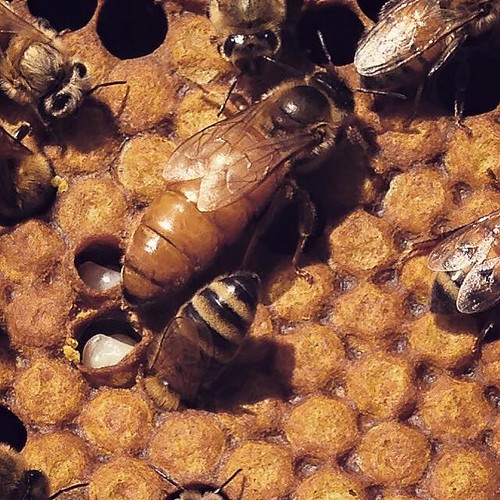
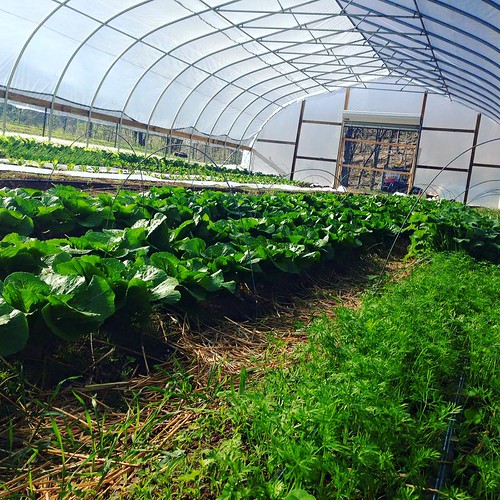
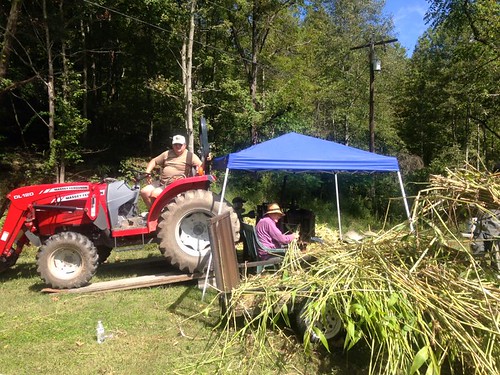
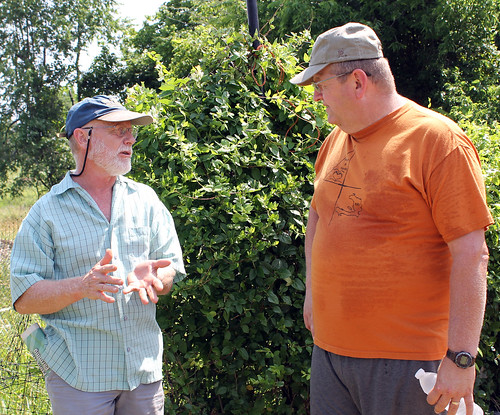

Posted by Sam Rikkers, Administrator, Rural Business Service, on April 29, 2016 at 10:00 AM

Eric Grandon and his family sell their local food products at a Farmer's Market in Clay County, West Virginia.
Eric Grandon of West Virginia is a war hero in the truest sense. Spending nearly 20 years in the Army, he was a combat veteran in Operation Desert Storm, Operation Iraqi Freedom II, and participated in four peace-time missions to the Middle East. Yet, when a horrific flashback overtook him in 2011, he was unable to continue his job as a Physical Therapist Assistant and was deemed unemployable and permanently disabled from PTSD. Unable to work, he found himself wandering around his farm aimlessly for nearly two years until he met James McCormick, the present Director of the Veterans and Warriors Agriculture program under the West Virginia Department of Agriculture.
A veteran himself, McCormick encouraged Grandon to take up farming, which had helped him work through his own PTSD. It was during a USDA Armed to Farm conference hosted by the National Center for Appropriate Technology (NCAT) that Grandon officially decided to become a farmer. He even took up beekeeping which he found to be the most therapeutic of them all often bringing tears of joy to his eyes.
“It seemed the more I worked the ground, the less I was haunted,” Grandon commented. “I can truly say, agriculture has saved me from myself.”

Working with his bees brings Grandon a true sense of peace.
Since then, ATTRA Sustainable Agriculture has been his “one stop shop” for information on how to run, fund, manage, and expand his farm. He is a Homegrown Hero and even received a generous grant from the USDA’s Natural Resource Conservation Service (NRCS) EQIP program to build a high tunnel where he now harvests 300 heads of romaine lettuce for four separate county school systems. Without these organizations, Grandon explains, he would not be a successful farmer today.

Grandon's high tunnel grows lettuce and other greens. A USDA NCRS grant made it all possible.
And perhaps that is what Grandon is most proud of now. His crops – broccoli, kale, spinach, sweet pepper, and watermelon amongst others – provide a local, delicious, and nutritious product to four local county school systems. At Sugar Bottom Farm, they do not use herbicides, pesticides, or synthetic fertilizer on their products.

From novice to professional in less than 3 years, Eric Grandon claims he could not have done it without the assistance of USDA and ATTRA/NCAT.
As the White House celebrates Local Food month, USDA hopes to recognize Homegrown Heroes like Eric Grandon who are bringing local food to their communities. Coming from a USDA designated StrikeForce community, where more than 20% of the population lives in poverty, Eric Grandon has used agriculture to change not only his life, but the lives of all others around him.

Grandon attends a farming training session with NCAT where he learns how to grow his produce more efficiently.
Are you a veteran interested in farming? Or a new farmer looking for guidance and support? Check out how our USDA programs can also help you as they helped Eric Grandon: newfarmers.usda.gov.

Homegrown by Heroes Logo
Related Posts
Tags: EQIP, Farmers, high tunnels, KYF2, local food, local foods, new farmers, NRCS, RD, StrikeForce, U.S. Army,veteran farmers, veterans, West Virginia, White House
National Grasslands – Celebrating and Conserving Open Space
From the #USDA:


Posted by Vern Koehler and Jane Knowlton, U.S. Forest Service, on April 28, 2016 at 5:00 PM

Summer clouds dance over the Miller Hills on the Thunder Basin National Grasslands. Forest Service photo by Christi Painter
Many know about America’s Great Plains, the vast, far-as-you-can-see mostly flat lands in the country’s interior west of the Mississippi River and east of the Rocky Mountains, consisting of prairie, steppe and grasslands. The 20 national grasslands and the Midewin National Tallgrass Prairie are part of this heartland tapestry, rich in stories about history, ecological health, business and job opportunities, adventures in recreation, and now—part of the U.S. Forest Service’s urgent mission to conserve open space.
During America’s westward expansion in the 1800s, a once teeming herd of bison was largely eliminated as ranchers, soldiers, prospectors and railroad builders pushed back the last frontier. The Homestead Act of 1862 brought almost six million settlers who replaced grass with crops more beneficial to their economic aspirations.
Prolonged drought, bitter winters and overly plowed land exposed rich dark topsoil to incessant dry winds. Together these factors created what came to be known as the Dust Bowl of the 1930s, further exasperating the harsh economic downturn of the Great Depression.
Emergency legislative measures to save the farmers and settlers allowed the federal government to purchase and restore damaged lands and to resettle destitute families. Following this conservation trend, in June 1960, the national grasslands were created under Forest Service stewardship.
Today, these grasslands tell an outstanding conservation success story. Revegetated to provide for soil and water conservation, these intermingled public and private lands are managed to conserve the natural resources of grass, water and wildlife habitat. Clean water flows off restored watersheds to nourish communities miles downstream. Wildlife thrives in reborn habitats and the soil has regained its fertility. Livestock ponds expand the range of many wildlife species by providing water while allowing for more cattle to graze.
National grasslands are managed for multiple sustainable uses, while producing a variety of goods and services to help maintain rural economies and lifestyles. Rich in mineral, oil and gas resources, they also provide diverse recreational uses such as mountain bicycling, hiking, hunting, fishing, photographing, birding, and sightseeing.
Yet the open space these lands offer face new challenges. They lie within grassland ecosystems that are becoming scarcer every day.
At one time, grasslands covered approximately 500,000 square miles in the United States. Today only about two percent or 10,000 square miles remain and the Forest Service manages nearly 60 percent or 6,000 of those miles. The National Forests on the Edge publication estimates that 21 million acres of private rural lands near national forests and grasslands will experience substantial housing density increases by 2030.
For almost 80 years, the laws and policies that guide the US Forest Service have focused on conserving open space as part of the grasslands mission. The aesthetic beauty, economic value, and social benefits of open spaces are a keystone in the Forest Service’s stewardship of these national treasures.

Springtime marks the mating season for sage grouse when males gather at dawn for their dancing displays on “leeks,” open natural dance floors in the sagebrush such as this one on the Thunder Basin National Grassland. Forest Service photo by Christi Painter
Related Posts
Conversations with Organic PA Farmers on Crop Insurance
From the #USDA:
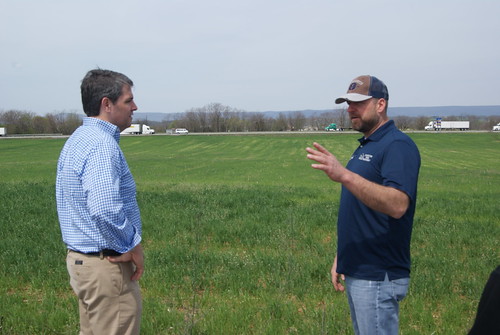
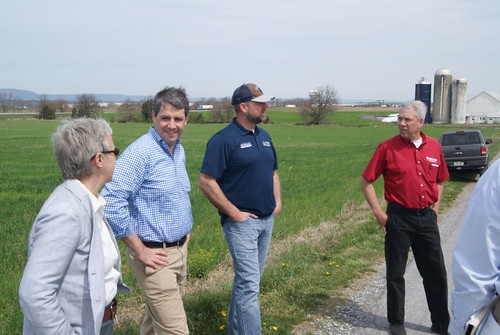
Posted by Tim Gannon, Risk Management Agency Associate Administrator, on April 28, 2016 at 4:00 PM

USDA Risk Management Agency Associate Administrator Tim Gannon (left) and Jason Forrester talk about planting plans on one of Forrester’s farms in Chambersburg, Pa.
I hit the road last week to get feedback from farmers in Pennsylvania on how recent Federal crop insurance enhancements are helping organic producers in the state.
Earlier this year, USDA expanded crop insurance options to allow organic producers to purchase coverage that better reflects their product’s actual value. The expanded coverage is part of our continued commitment to provide farmers with resources and tools to meet the growing demand for certified organic products.
The organic sector has experienced remarkable growth, representing more than $39 billion in U.S. retail sales. This growth creates opportunities for farmers and businesses across the country. Expanding the safety net for farmers wanting to enter the organic market ensures they have the tools and resources they need.
Hannah Smith-Brubaker, Deputy Secretary of Pennsylvania’s Department of Agriculture, joined me during my visits to two farms in Chambersburg, Pennsylvania.
We met with Jason and Tony Forrester, cousins who have multiple farms in the Chambersburg area. Both have Federal crop insurance policies that cover certified organic crops including corn, soybeans and wheat.
Jason Forrester, who has nearly 900 acres, all certified organic or in transition, told me he “never bats an eye” at paying his policy premium. “If not me, I know some farmer, somewhere, is going to need it,” he said.
Last year, USDA reported that U.S. certified and exempt organic farms sold a total of $5.5 billion in organic products in 2014, up 72 percent since 2008. There were more than 6,000 organic crop insurance policies in effect in 2014.
Jason said that farmers don’t even have to advertise their organics products because the buyers “come to you.” And many of those buyers are local. He sells some products to a local creamery operation right down the street from one of his farms.
Among the changes discussed for 2016 was the Contract Price Addendum, which allows producers transitioning to certified organic to cover their production of 73 eligible crops at a higher price than traditional crops.
Also in 2016, RMA continued to add to the number of crops eligible for an organic premium price election. That’s now up to 57 commodities for the 2017 crop year.
We received a lot of good feedback during our visit. RMA is constantly seeking input from producers on how we can improve crop insurance products, which have become such a huge part of the safety net available to American ranchers and farmers.
USDA has also established a number of resources to help organics producers find technical and financial resources to help them grow domestically and abroad. You can visit www.usda.gov/organicto learn more about USDA’s support to the organic industry. More information on risk management tools available for agricultural producers is available at the RMA website. That includes a fact sheet on the Contract Price Addendum and other information specifically geared toward organic and transitioning farmers.

(From left) Pennsylvania Department of Agriculture Deputy Secretary Hannah Smith-Brubaker, USDA Risk Management Agency Associate Administrator Tim Gannon, Jason Forrester and Tony Forrester talk about crop insurance for organic farmers at one of their farms in Chambersburg, Pa.
Related Posts
Philadelphia Prisons System recognized by EPA for its food recovery program - Renewable Energy From Waste
The system compost most than 1.35 tons of food waste each day.
Philadelphia Prisons System recognized by EPA for its food recovery program - Renewable Energy From Waste
Philadelphia Prisons System recognized by EPA for its food recovery program - Renewable Energy From Waste
Thursday, April 28, 2016
Osprey & Snack
April 28, 2016
From the U.S. Fish and Wildlife Service:
Osprey savors an afternoon snack at Bombay Hook National #WildlifeRefuge in Delaware!
Photo: Jon Lloyd Jr.
From the U.S. Fish and Wildlife Service:
Osprey savors an afternoon snack at Bombay Hook National #WildlifeRefuge in Delaware!
Photo: Jon Lloyd Jr.
Pollinator Monarch Butterfly
April 28, 2016
From USFWS Northeast Region:
So many reasons to visit Philadelphia - statue of Rocky Balboa, John Heinz National Wildlife Refuge At Tinicum, pollinator garden behind Independence Hall. That's right - thanks to refuge staff andStudent Conservation Association, pollinators like monarch butterflies will have a special place to stay in the City of Brotherly Love. http://bit.ly/1SN8Goz
From USFWS Northeast Region:
So many reasons to visit Philadelphia - statue of Rocky Balboa, John Heinz National Wildlife Refuge At Tinicum, pollinator garden behind Independence Hall. That's right - thanks to refuge staff andStudent Conservation Association, pollinators like monarch butterflies will have a special place to stay in the City of Brotherly Love. http://bit.ly/1SN8Goz
Wednesday, April 27, 2016
News Release
U.S. Environmental Protection Agency
New England Regional Office
April 27, 2016
Contact: David Deegan, (617) 918-1017
EPA Proposes to Designate a Dredged Material Disposal Site in Eastern Long Island Sound
BOSTON – The US Environmental Protection Agency (EPA) today issued a proposal to designate a dredged material disposal site to serve the eastern Long Island Sound region. The Eastern Long Island Sound Disposal Site (ELDS) would be located offshore from New London, Connecticut, and would be available for the disposal of dredged material from harbors and navigation channels in eastern Long Island Sound in the states of Connecticut and New York.
EPA is proposing the same restrictions on the use of this site as it proposed for the central and western Long Island Sound disposal sites, to support the goal of reducing or eliminating open-water disposal of dredged material in the Sound. These restrictions are intended to promote the beneficial use of dredged material, such as beach nourishment, or other alternatives to open-water disposal whenever practicable.
The proposed action is described in a draft rule and Draft Supplemental Environmental Impact Statement (DSEIS) that also is being released today for public comment. These documents are available for public review and comment until June 27, 2016. EPA will hold two public hearings on the proposed rule on May 25 and May 26. The DSEIS is considered supplemental because it updates and builds on analyses that were conducted for the 2005 Long Island Sound Environmental Impact Statement that supported the designation of the Central and Western Long Island Sound dredged material disposal sites. The DSEIS recommends designation of the ELDS as the preferred alternative from the range of options considered.
EPA determined that a site was necessary because there are currently no disposal sites designated for long-term use in the eastern Long Island Sound region, the dredging needs exceed the available capacity at existing sites, and the regulations require EPA designation for any long-term dredged material disposal site. The U.S. Army Corps of Engineers (USACE) estimates the dredging needs in eastern Long Island Sound to be approximately 22.6 million cubic yards over the next 30 years.
While EPA, the USACE, and the states of Connecticut and New York are committed to developing and promoting the use of alternatives to open-water disposal, EPA has determined that an open-water disposal site still is necessary in case an alternative is not available for some projects. Periodic dredging of harbors and channels is essential for ensuring safe navigation and facilitating marine commerce and recreation.
The designation of dredged material disposal sites by EPA only makes those sites available for use by future dredging projects; it does not authorize the disposal of any material from any project. Any proposal to place dredged material at the ELDS will have a project-specific authorization and must satisfy the stringent requirements of the ocean disposal regulations. Dredged material that does not pass the stringent testing requirements and is determined to be toxic are not, and will not in the future, be placed in the open waters of Long Island Sound. These materials currently and in the future will require either containment or treatment.
EPA will hold four public hearings to receive comments on the proposed rule and DSEIS. Registration will begin 30 minutes before each of the four hearings:
- May 25, 2016 in New York from 1:00 – 3:00 p.m. at the Suffolk County Community College Culinary Arts Center, 20 East Main St., Riverhead, NY, 11901 and 5:30 – 7:30 p.m. at the Mattituck-Laurel Library, 13900 Main Rd., Mattituck, NY, 11952.
- May 26, 2016 in Connecticut from 1:00 – 3:00 p.m. and from 5:00 – 7:00 p.m. at the University of Connecticut – Avery Point, Academic Building, Room 308, 1084 Shennecossett Rd, Groton, CT, 06340.
Following consideration of the comments received, EPA will issue a Final SEIS which will include written responses to comments.
More information:
- Dredged material management in Long Island Sound and EPA’s proposed rule: https://www.epa.gov/ocean-dumping/dredged-material-management-long-island-sound
- Comments on the proposed rule and DSEIS may be submitted to ELIS@epa.gov or mailed to: Jean Brochi, USEPA, 5 Post Office Square, Suite 100, Mail Code: OEP06-1, Boston, MA 02109.
# # #
U.S. Environmental Protection Agency
New England Regional Office
April 27, 2016
Contact: David Deegan, (617) 918-1017
EPA Proposes to Designate a Dredged Material Disposal Site in Eastern Long Island Sound
BOSTON – The US Environmental Protection Agency (EPA) today issued a proposal to designate a dredged material disposal site to serve the eastern Long Island Sound region. The Eastern Long Island Sound Disposal Site (ELDS) would be located offshore from New London, Connecticut, and would be available for the disposal of dredged material from harbors and navigation channels in eastern Long Island Sound in the states of Connecticut and New York.
EPA is proposing the same restrictions on the use of this site as it proposed for the central and western Long Island Sound disposal sites, to support the goal of reducing or eliminating open-water disposal of dredged material in the Sound. These restrictions are intended to promote the beneficial use of dredged material, such as beach nourishment, or other alternatives to open-water disposal whenever practicable.
The proposed action is described in a draft rule and Draft Supplemental Environmental Impact Statement (DSEIS) that also is being released today for public comment. These documents are available for public review and comment until June 27, 2016. EPA will hold two public hearings on the proposed rule on May 25 and May 26. The DSEIS is considered supplemental because it updates and builds on analyses that were conducted for the 2005 Long Island Sound Environmental Impact Statement that supported the designation of the Central and Western Long Island Sound dredged material disposal sites. The DSEIS recommends designation of the ELDS as the preferred alternative from the range of options considered.
EPA determined that a site was necessary because there are currently no disposal sites designated for long-term use in the eastern Long Island Sound region, the dredging needs exceed the available capacity at existing sites, and the regulations require EPA designation for any long-term dredged material disposal site. The U.S. Army Corps of Engineers (USACE) estimates the dredging needs in eastern Long Island Sound to be approximately 22.6 million cubic yards over the next 30 years.
While EPA, the USACE, and the states of Connecticut and New York are committed to developing and promoting the use of alternatives to open-water disposal, EPA has determined that an open-water disposal site still is necessary in case an alternative is not available for some projects. Periodic dredging of harbors and channels is essential for ensuring safe navigation and facilitating marine commerce and recreation.
The designation of dredged material disposal sites by EPA only makes those sites available for use by future dredging projects; it does not authorize the disposal of any material from any project. Any proposal to place dredged material at the ELDS will have a project-specific authorization and must satisfy the stringent requirements of the ocean disposal regulations. Dredged material that does not pass the stringent testing requirements and is determined to be toxic are not, and will not in the future, be placed in the open waters of Long Island Sound. These materials currently and in the future will require either containment or treatment.
EPA will hold four public hearings to receive comments on the proposed rule and DSEIS. Registration will begin 30 minutes before each of the four hearings:
- May 25, 2016 in New York from 1:00 – 3:00 p.m. at the Suffolk County Community College Culinary Arts Center, 20 East Main St., Riverhead, NY, 11901 and 5:30 – 7:30 p.m. at the Mattituck-Laurel Library, 13900 Main Rd., Mattituck, NY, 11952.
- May 26, 2016 in Connecticut from 1:00 – 3:00 p.m. and from 5:00 – 7:00 p.m. at the University of Connecticut – Avery Point, Academic Building, Room 308, 1084 Shennecossett Rd, Groton, CT, 06340.
Following consideration of the comments received, EPA will issue a Final SEIS which will include written responses to comments.
More information:
- Dredged material management in Long Island Sound and EPA’s proposed rule: https://www.epa.gov/ocean-dumping/dredged-material-management-long-island-sound
- Comments on the proposed rule and DSEIS may be submitted to ELIS@epa.gov or mailed to: Jean Brochi, USEPA, 5 Post Office Square, Suite 100, Mail Code: OEP06-1, Boston, MA 02109.
# # #
Florida cites FPL cooling canals for violating water quailty laws | Miami Herald
Days after issuing a controversial plan for managing the troubled cooling canal system at Turkey Point, state environmental officials have cited Florida Power & Light for threatening nearby drinking water supplies and ordered the utility to hammer out a fix to stop the spread of an underground plume of saltwater.
In a notice to FPL officials Monday, the Department of Environmental Protection gave the utility 21 days to provide any information about how the 40-year-old canals have seeped into the Biscayne aquifer over the years and enter negotiations to come up with a clean-up plan. If the two sides fail to agree, the agency may come up with its own measures in 60 days, the notice said.
Read more here: http://www.miamiherald.com/news/local/environment/article74044347.html#storylink=cpy
Florida cites FPL cooling canals for violating water quailty laws | Miami Herald
Zoo Miami’s Ron Magill caught up in a feral cat fight | Miami Herald
Remember Ron Magill?
Poor Ron. Used to be a folk hero hereabouts. A world renowned conservation crusader. Not just Zoo Miami’s, but all of Miami’s goodwill ambassador. About as beloved as anyone in this town.
Read more here: http://www.miamiherald.com/news/local/news-columns-blogs/fred-grimm/article74283292.html#storylink=cpy
Zoo Miami’s Ron Magill caught up in a feral cat fight | Miami Herald
Cute Goslings
April 27, 2016
From San Francisco Bay NWR Complex:
More cute photos of goslings! Photo: Michael Lufting
From San Francisco Bay NWR Complex:
More cute photos of goslings! Photo: Michael Lufting
Virginia Bluebells
April 27, 2016
Virginia bluebells have been popping up along wooded river floodplains and other wet forests. These wildflowers are a great nectar source for monarchs and other butterflies.
Photo: Virginia bluebells courtesy of Brian/Creative Commons. https://flic.kr/p/spTx5L
#Wildflower
Virginia bluebells have been popping up along wooded river floodplains and other wet forests. These wildflowers are a great nectar source for monarchs and other butterflies.
Photo: Virginia bluebells courtesy of Brian/Creative Commons. https://flic.kr/p/spTx5L
#Wildflower
Tipton Kangaroo Rat
April 27, 2016
From Kern National Wildlife Refuge Complex:
Our Wildlife Refuge Biologist has been conducting Tipton kangaroo rat surveys on Kern Refuge. With the help of the Endangered Species Recovery Program (ESRP), Kern refuge continues to be one of the last remaining areas where these small rodents reside.
From Kern National Wildlife Refuge Complex:
Our Wildlife Refuge Biologist has been conducting Tipton kangaroo rat surveys on Kern Refuge. With the help of the Endangered Species Recovery Program (ESRP), Kern refuge continues to be one of the last remaining areas where these small rodents reside.
Subscribe to:
Comments (Atom)










